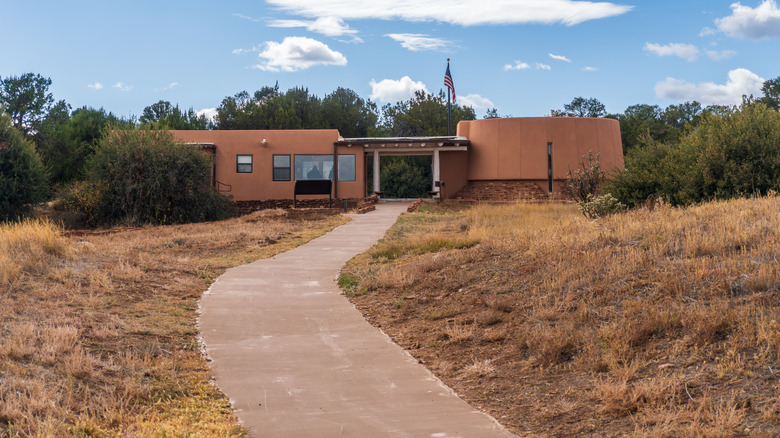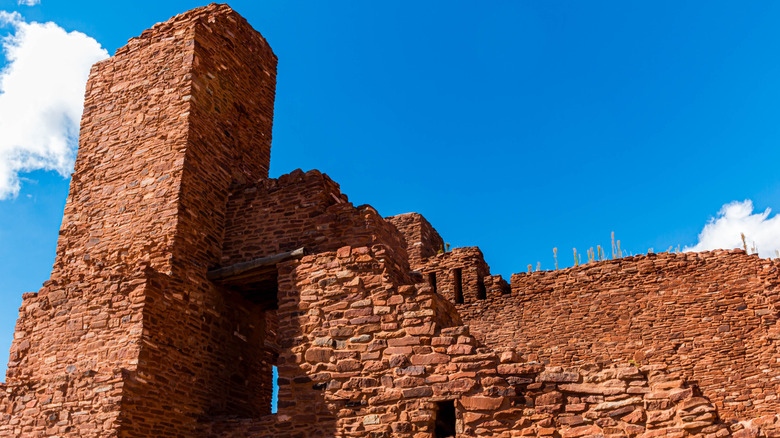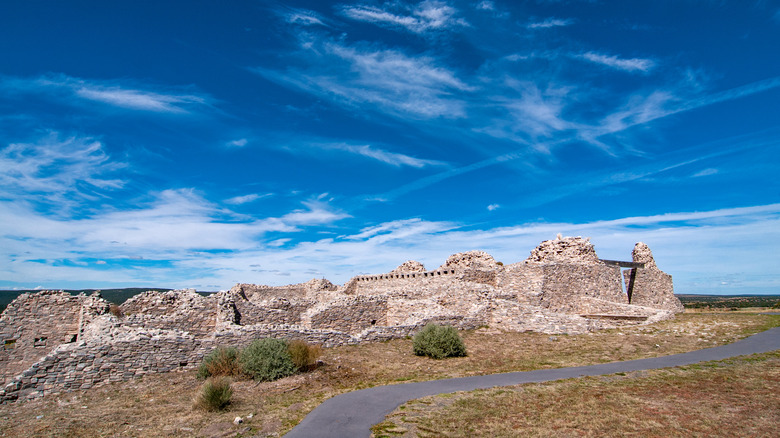Outside Of Albuquerque Are Three New Mexico Monuments Rich With History, Structures, And Beauty
If you're interested in Indigenous history, ancient architecture, or beautiful ruins, you need to make your way to central New Mexico. Located just 93 miles from Albuquerque (home of the world's largest hot air balloon fiesta), the Land of Enchantment allows visitors to explore a high-desert treasure: Salinas Pueblo Missions National Monument. The attraction is composed of three separate sites: Quarai, Abó, and Gran Quivira. Each shares insight on and context for the conflicts between Spanish missionaries (and other Europeans settlers) and the native Pueblo people. At every site, you will find pueblos built by Indigenous communities, Spanish missions constructed in the 17th century, and numerous ruins and other historic structures. Additionally, each location has picnic areas, a visitor center, interpretive trails, and wayside exhibits.
For a great overview of all three sites, stop by Mountainair Headquarters Visitor Center. Located in the town of Mountainair (a place often referred to as "The Gateway to Ancient Cities"), the visitor center invites travelers to chat with rangers and learn about the people and history of the New Mexico frontier. While there, you can also get information about each site's activities, which include self-guided walks, stargazing, picnicking, and ranger-led tours.
To visit Salinas Pueblo Missions National Monument, sightseers can fly into Albuquerque International Sunport and drive for less than 90 minutes to reach Mountainair. Before straying too far from the airport, consider adding Albuquerque's Indian Pueblo Cultural Center (a great place to learn about Pueblo history, art, and recipes or start a tour of New Mexico's 19 pueblos) and Old Town district (a historic area with over 150 restaurants, shops, and museums) to your travel itinerary, too. If you have more time to spare, this road trip route is worth trying to see some of the Southwest's best parks.
Explore Salinas Pueblo Missions' Abó and Quarai sites
Abó, located about 6 miles from Mountainair, is Salinas Pueblo Missions National Monument's oldest pueblo. The site spans about 370 acres and contains numerous pit houses, jacales (huts), and even unexcavated ruins dating back to roughly 1300 A.D. It's also home to San Gregorio de Abó, the monument's oldest mission, established in 1622. There, visitors can view the church's red sandstone remains (which are considered to be spectacular examples of perfectly thought out Southwestern architecture). Don't leave before walking along the Abó Mission Loop, which takes visitors around the mission and a Native American kiva (round or rectangular Pueblo buildings used for ceremonies) nearby. Considered an easy walk, this paved interpretive loop is just under a mile-long.
At Quarai, the national monument's southernmost pueblo, you'll see the land the Tiwa people called home. Here, visitors can view prehistoric ruins, including a Tiwa Pueblo and Spanish Mission (both from the 17th Century), a small 19th century church and ranchero, and numerous artifacts. La Nuestra Senora de la Purisima Concepcion de Cuarac Mission ruins, which was completed in 1632 after five years of building, is the most complete church at the National Monument. Guests can see from the ruins that the church (which was around 108 feet long and 28 feet wide) was shaped like a Latin cross. Visitors can hike the half-mile Mission Loop Trail (rated an easy walk) and/or the mile-long Spanish Corral Loop(also considered an easy walk), that showcases the area's primitive and natural wilderness. Taos, home to a pueblo that has been inhabited for the past 1,000 years, makes a great add-on destination.
Don't forget to visit Gran Quivira Mission
Gran Quivira, formerly known as Las Humanas, sits on just over 600 acres and is the largest of the three ruin sites at Salinas Pueblo Missions National Monument. It also has a different look as the ruins were made from grey San Andreas limestone and not the red sandstone used in the other two pueblos. Gran Quivira also has the distinction of being the only site in the monument with two churches (San Isidro de las Humanas and San Buenaventura de las Humanas), each with a separate and distinct mission complex.
The landscape surrounding Gran Quivira is unique as well; it is located at a "geographic crossroads" near the southeast side of the Chupadera Mesa; residents could look east and see the Great Plains, see mountains to the north and west, and view the Tularosa basin if they looked south. Ruins of pueblos (historic and prehistoric), pit houses, homesteads from the 19th and 20th centuries, and numerous artifacts can be viewed at Gran Quivira. Evidence of the Spaniards influence on the pueblo residents can be found in recovered artifacts including religious medallions, metal tools and European-inspired styles of pottery; there is also proof that the pueblo residents began having livestock, such as cattle, sheep, pigs, goats, and horses. Enjoy a leisurely, self-guided walk around the site. Gran Quivira Mission Loop is an easy three-quarters-mile walk through the mission and the pueblo.
Before arriving at the Salinas Pueblo Missions National Monument, be sure and check out their calendar of events for special programs and activities. Popular events include "Dark Skies, Bright Stars!" and "Basics of Outdoor Photography Workshop." If you're looking for more living history to explore while in New Mexico, check out the historic village of Cochiti and the pueblo that 1,500 people call home.


